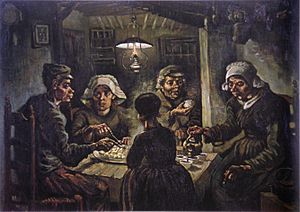

A Word in Your Ear
by Caroline Jenner
A somewhat bizarre exhibit went on display at the Centre for Art and Media in Karlsruhe, Germany, in June 2014. The exhibition which will run until July 6, 2014 comprises a replica of Vincent van Gogh's ear grown using genetic material from the living cells of Lieuwe van Gogh, the great-great-grandson of Vincent's brother Theo. The replica was made by artist Diemut Strebe. Using computer imaging technology, the cells had been shaped to resemble the ear that van Gogh purportedly cut off in 1888. The living exhibit is being suspended in a nutrient solution which, hypothetically, could keep it alive for several years.
Vincent Willem van Gogh was born in Holland in 1853 and died a mere 37 years later from an (apparently self-inflicted) gunshot wound. Considering that along with Rembrandt he is probably the best-known of all Dutch painters, it is incredible to think that in his lifetime his work was relatively unappreciated. In fact, he is said to have sold only one work- and that for a pittance - during his lifetime.
It is perhaps less surprising that nowadays he is best known for having lost an ear by an act of self-mutilation. As far as his art is concerned, he is identified mainly in the "popular" mind by his series of sunflower paintings that have been extensively used to decorate chocolate boxes and for "painting by number" exercises. Yet in just over ten years from his late twenties to his death at 37 he produced more than 2000 works of art, including oil paintings, watercolours, drawings, sketches and prints. He covered the complete range of portraits (including many self-portraits), landscapes and still lifes.
Van Gogh started drawing as a child and his artwork continued in that medium until he was in his late twenties, when he began painting. As a young man he worked for a firm of art dealers and travelled regularly between the Netherlands, the United Kingdom, Belgium and France. His first major work, called The Potato Eaters, was produced in 1885, a mere five years before his death. It is very sombre and bears no hint of the vibrant colours and vitality that were to become his hallmark style in the future.

The later lightening of his work was partly the result of his time in France after 1886, when he was greatly influenced by friendship with Degas, Pissarro, Seurat and particularly Gauguin. But from this time onwards his mental health began to suffer. It was in 1888, the same year that he suffered the loss of his ear, that van Gogh moved to Arles in the south of France where he painted his famous series of Sunflowers. Much of this time, too, was spent in the company of his friend Gauguin whose works also displayed the same vibrancy and bright colours that were then exhibited by van Gogh. After two years of continued ill health and depression, years that were also marked by an almost frenetic period of painting, he took his own life.
What caused this sad life and death of this tormented soul? Van Gogh wrote a lot and referred frequently to his disturbed mental state, but there seems to have been no definitive answer. Early on, we know, he had two unhappy romances that troubled him greatly. This clearly contributed to his nervous temperament and his health was further undermined by the frenetic way he lived and worked. From 1888, when he lopped off his ear lobe, he alternated between bouts of madness and lucidity, and was confined to an asylum for treatment.
By May 1890 he appeared to be recovered, but two months later he shot himself. The real cause will have to remain an enigma. But perhaps some hints exist in some of his writings from which I quote:
“It is good to love many things, for therein lies the true strength, and whosoever loves much performs much, and can accomplish much, and what is done in love is well done.”
“Be clearly aware of the stars and infinity on high. Then life seems almost enchanted after all.”
“I dream my painting and I paint my dream.”
“A great fire burns within me, but no one stops to warm themselves at it, and passers-by only see a wisp of smoke”
“I put my heart and soul into my work, and I have lost my mind in the process.”
“I don't know anything with certainty, but seeing the stars makes me dream.”
“I would rather die of passion than of boredom.”
“The sadness will last forever.”